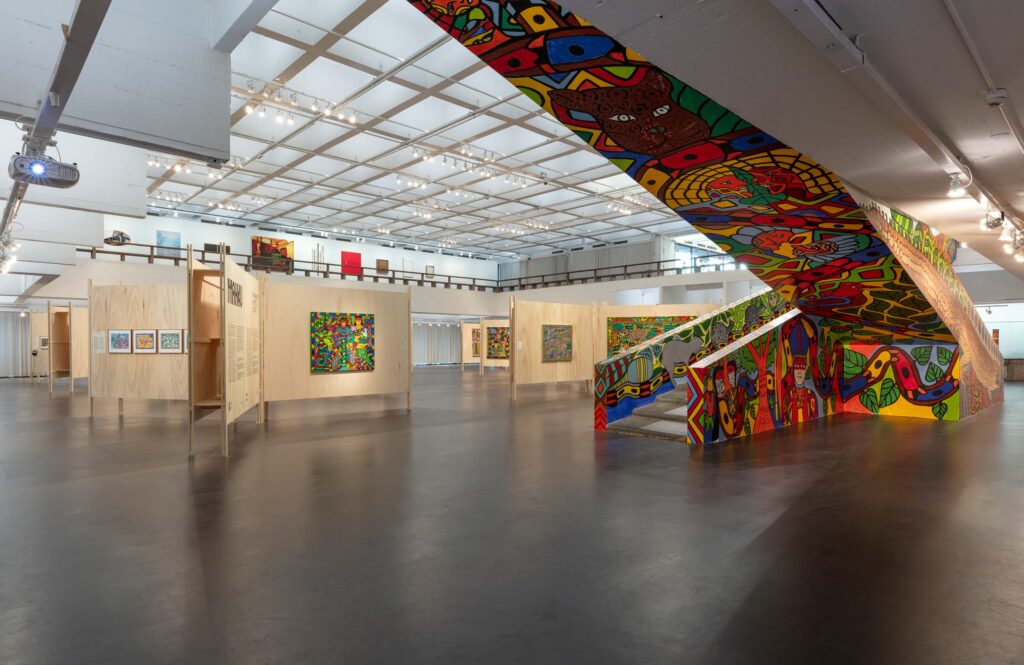Movimento dos Artistas Huni Kuin (“MAHKU Movimento”)
The MAHKU Movimento (Movimento dos Artistas Huni Kuin) is a group of indigenous Huni Kuin artists based in the Indigenous Lands of the Jordão River in the State of Acre, Brazil (a region called Kaxinawá by the Huni Kuin). Founded in 2013 by Isaías Sales (Ibã) and his sons Acelino, Bane, and Maná, the group preserves and promote the spiritual, linguistic, and cultural traditions of the Huni Kuin people through contemporary art. Their work focuses on translating ritual chants, often performed while drinking Ayahuasca (a traditional South American psychedelic medicine), into large-scale monuments and vibrant, visual narratives. Through the translation of this traditional practice into a visual medium, MAHKU preserves the long histories of their myths and spiritual symbols, rooted in ancestral knowledge. MAHKU bridges oral tradition and the legacies of medicinal rituals to visual expression, offering Indigenous and non-Indigenous audiences innovative ways to engage with and understand the cosmologies and wisdom of the Huni Kuin.
Beyond their artistic output, MAHKU plays a critical role in advocating for Indigenous rights, land protection, and environmental justice. Their murals serve as much more than just aesthetic statements; they are tools of anti-colonial resistance and platforms for dialogue about Indigenous rights, liberation, and memory-care work. The group continues to navigate challenges related to land encroachment and cultural appropriation, while keeping their traditions alive and accessible to others through art.

City
Country
Region
Year of Creation
Featured Project

Resources
Goulart, Sandra Lúcia. “The Expressive Forms of Amazonian Indigenous Peoples and Ayahuasca: the Huni Kuin and other Pano groups.” Anthropology of Consciousness, vol. 34, no. 2, 2023, https://doi.org/10.1111/anoc.12179.
Langlois, Jill. “A Brazilian Artist Movement That Uses Paintings to Save Indigenous Culture.” The New York Times, 4 Dec. 2024, https://www.nytimes.com/2024/12/04/arts/design/brazil-art-mahku-miami-basel-indigenous.html.
“MAHKU.” 35ª Bienal de São Paulo, 2023, https://35.bienal.org.br/en/participante/mahku/.
“MAHKU (MOVIMENTO DOS ARTISTAS HUNI KUIN).” La Biennale Di Venezia, https://www.labiennale.org/en/art/2024/nucleo-contemporaneo/mahku-movimento-dos-artistas-huni-kuin.
“MAHKU: Visions | 3.24 – 6.4.2023 | Documentary Video.” Uploaded by Museu de Arte de São Paulo Assis Chateaubriand to YouTube, 1 Jun. 2023, https://youtu.be/BCbf3ztvCaE?si=kofS6A91CRFexlx_.
Mattos, Amilton. “Why MAHKU – Movimento Dos Artistas Huni Kuin – Sing?” GIS – Gesto, Imagem, Som – Revista De Antropologia, vol. 2, no. 1, 2017, pp. 61–82. https://www.academia.edu/37121741/Why_MAHKU_ Movimento_dos_Artistas_Huni_Kuin_sing.
Nunes, Mateus. “MAHKU’s Mythology of the Brazilian Amazon.” 30 May 2023, https://artreview.com/mahku-visions-masp-sao-paulo-review/.
More Information
IMPORTANT: Profile pages for all collectives are in permanent development and have been built using information in the public domain. They will be updated progressively and in dialogue with the organizations by the end of 2024. New features and sections will be included in 2025, like featured videos, and additional featured projects. Please contact us if you discover errors. For more information on mapping criteria and to submit your organization’s information to be potentially included in the database, visit this page

